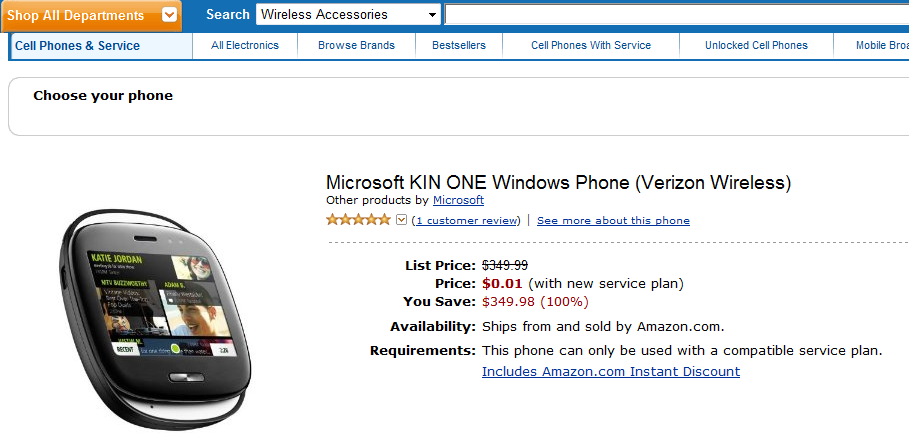Kin: More proof that warring fiefdoms rule at Microsoft

We Microsoft watchers are all armchair quarterbacking today, the day after Microsoft basically pulled the plug on its short-lived Kin phones for the teen/twenty-something market.
The pricey Verizon data plan killed it, some say. Microsoft decision to redo the Java-centric Danger OS and turn it into a Windows Embedded Compact one marked the beginning of the end, say others. A lack of downloadable apps, weird ad campaigns, phones that attempted to straddle the feature-phone/smartphone market all are cited as the Kin's undoing.
But I haven't seen many folks look closely at the Kin development timeline.
In the early days of its development, Kin (then known as Pink), was going to share the same core as Windows Mobile 7. But Microsoft decided to do a Longhorn-style reset and scrapped the WM 7 project. One result was a delay in the delivery of its next mobile operating system. In fact, neither the Windows Embedded Compact 7 core, nor the Windows Phone 7 operating system has been released to manufacturing yet. That meant the Kin team couldn't use these components; they had to use an older version of the Windows Embedded Compact operating system.
A couple of May posts on the anonymously-penned Mini Microsoft blog made reference to the internal skirmishes over the operating system for the Kin phones. Yes, these comments are anonymous and could be from trolls rather than actual Softies, but they're pretty detailed if they're fake. Here are two pertinent comments:
Anonymous said:
Glad you named KIN, as I used to work there until few months ago. KIN was a great and ambitious project...until May 2009. The business, marketing, design vision was just spectacular! In May 2009, Mr. Myerson, decided to kill it because it was competing with his own baby, WP7. Since WP7 was not ready (still today is by far ready!) the exec told him KIN would continue. As retaliation, he killed the support of his team to KIN project. Guess what? KIN team had to take over a lot of base code postponing all the value added apps+services. Now you get why there is lack of apps on KIN. Who will win in medium/long term? Mr Myerson obviously, that's why I decide to leave.
Monday, May 31, 2010 10:29:00 AM
(The "Mr. Myerson" here is Terry Myerson, the head of Windows Phone engineering.)
An "Anonymous" retort to the original "Anonymous":
The previous poster conveniently neglects the fact that Kin's original plans were unrealistic - they were going to release a WP7 based device before WP7 was complete. It ignores the fact that the core WP7 team needed to focus on shipping a WP7 phone and that supporting a different additional hardware platform runs counter to that.
Since WP7 was not ready (still today is by far ready!) the exec told him KIN would continue. As retaliation, he killed the support of his team to KIN project.
Had KIN management had any accountability, they would have built on top of the WP7 platform instead of grabbing several hundred people to do a one-off and then whining about the lack of support for an off platform device.
Guess what? KIN team had to take over a lot of base code postponing all the value added apps+services. Now you get why there is lack of apps on KIN. Who will win in medium/long term? Mr Myerson obviously, that's why I decide to leave.
Of course, the fact that for the 1st two years the Kin plan was NOT to provide a competing application platform seems to have gone unnoticed in your little post.
The beauty of Kin is indeed the online services, which should translate well to WP7 when the time comes. Everything else is a flaming turd. This is one of those cases where MCB should have gotten all of its wood behind one arrow. Instead, management spent millions on Danger and defocused the core teams on sideshow oddities such as Kin....
Tuesday, June 01, 2010 11:33:00 AM
Next page: So is Sinofsky the winner who will take all?
Another timeline I'd like to see is which happened first: Entertainment & Devices President Robbie Bach's and Chief Experience Officer J Allard's "decisions" to leave Microsoft or the top-level decision to kill the Kin.
Like any big company, Microsoft is plagued by lots of feuding fiefdoms. It's a dog-eat-dog world, even inside Microsoft's Mobile Communications Business. I wonder how the remaining Kin team members are going to feel now that they're being moved under the Windows Phone 7 leadership, if these posts are any indication of the rivalry between them.
Meanwhile, speaking of fiefdoms, the rumor that Windows President Steven Sinofsky is going to end up taking over the Microsoft Mobile business has heated up again. (That rumor originally started circulating in January 2010.)
Sinofsky already has a lot on his plate, heading up both Windows and Windows Live. And with Windows 8 beginning to take shape, he's going to be getting even busier in the coming months. However, I wouldn't be surprised to see Sinofsky triumph if he does decide he wants the mobile business, too.
As one of my tipsters, who asked to remain anonymous, said when I asked whether Sinofsky might end up running the mobile unit -- once CEO Steve Ballmer decides to relinquish control: "I'm sure of it based on the Windows 8 work and lack of new president for E&D. (Sinofsky) must have showed him the 3 release plan where he runs all of the Marketplaces, including mobile."
There could be an interesting shark-tank battle. I'm doubtful we'll see outgoing E&D President Robbie Bach or Chief Experience Officer J Allard do a Dick Brass and write an op-ed piece exposing the role the inter/intra-division rivalries play in Microsoft's product strategies. But maybe another exiting mobile employee might end up penning a tell-all....
